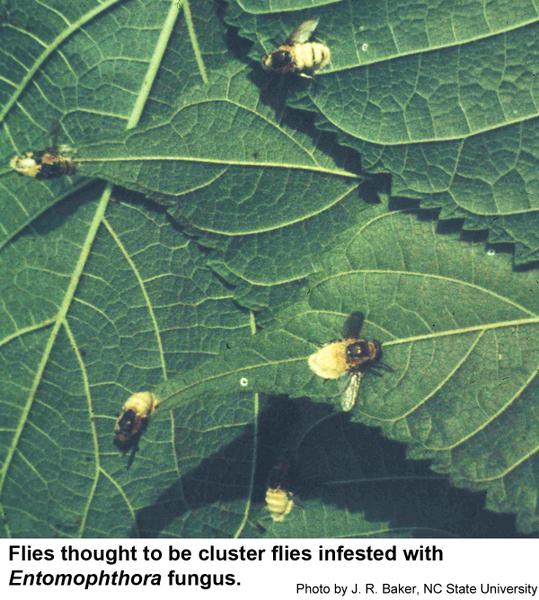General Information
Seedcorn maggot flies are greyish-brown and about one fifth inch long. The legs are black and it has bristles scattered on the body. Flies infested with an Entomophthora muscae fungus become bound to twigs, leaves, wires and other objects by their mouthparts. Infected flies are swollen and have pinkish bands on the abdomen. Sometimes gray Entomophthora spores are visible on the fly and on the substrate nearby. Seedcorn maggot eggs are tiny and white and have a coarse surface when viewed through a microscope. The white to creamy maggot grows to 1⁄4 inch long. It is legless and pointed at the head. The last larval skin hardens to form a dark brown, capsule-like puparium about 3⁄16 inch long.
Biology
The seedcorn maggot is found throughout North Carolina. Seedcorn maggots feed primarily on decaying organic matter, but sometimes infest the seeds and seedlings of vegetables. The dead, fungus-infected flies are sometimes abundant on the dead twigs of dogwood and crape myrtle in the spring. Although the fungus-infected flies appear to be "sucking the life" out of a plant, these adult flies are harmless. Most of the damage is caused by the maggot stages that sometimes kill germinating vegetable seeds; this results in poor stands and the need to replant. Injury is usually most severe during wet, cold seasons and on land rich in organic matter.
Most of the life cycle is spent in the soil of various field crops in the maggot stage. Flies emerge in May and deposit their eggs in soil where there is an abundance of decaying vegetable matter or seeds and young plants. The maggots hatch and burrow into seeds, often destroying the germ. They soon develop into puparia in the soil and in 12 to 15 days a new generation of adults emerges. There are three to five generations each year.
Some seedcorn maggot flies sometimes become infected with a fungus, Entomophthora muscae. This fungus apparently causes the flies to land on protruding objects such as any dead twigs of dogwood, crape myrtle, clothes lines, and fence posts. The flies cling there and usually die in the afternoon as their abdomens swell with fungal strands inside. Early the next morning, the fungal spores are released into the air while the humidity is high. The spores infest other flies, especially seedcorn maggot flies. The dead flies shrivel and eventually fall from the twigs.
Control
On dogwoods and other ornamentals, no control is necessary for the dead seedcorn maggot flies. Their presence indicates a natural control factor at work. For control of the maggots in vegetable gardens and field crops, shallow planting in well prepared seed beds sufficiently late in the season to get quick germination of the seed is probably the best means of control. Prompt replanting or resetting of damaged crops usually works well. The maggots are easily controlled by planting treated seeds.
Other Resources
- Entomophthora muscae, (=Entomophthora schizophorae) Zygomycetes: Entomophthorales. D. W. Watson. No Date. In Shelton, A. No Date. Biological Control, A Guide to Natural Enemies in North America.
- NC State Extension Plant Pathology Publications
- Insect and Related Pests of Shrubs
- NC State Horticultural Science Publications
- North Carolina Agricultural Chemicals Manual
For assistance with a specific problem, contact your local Cooperative Extension center.
Publication date: April 1, 1994
Reviewed/Revised: Sept. 18, 2019
Recommendations for the use of agricultural chemicals are included in this publication as a convenience to the reader. The use of brand names and any mention or listing of commercial products or services in this publication does not imply endorsement by NC State University or N.C. A&T State University nor discrimination against similar products or services not mentioned. Individuals who use agricultural chemicals are responsible for ensuring that the intended use complies with current regulations and conforms to the product label. Be sure to obtain current information about usage regulations and examine a current product label before applying any chemical. For assistance, contact your local N.C. Cooperative Extension county center.
N.C. Cooperative Extension prohibits discrimination and harassment regardless of age, color, disability, family and marital status, gender identity, national origin, political beliefs, race, religion, sex (including pregnancy), sexual orientation and veteran status.


